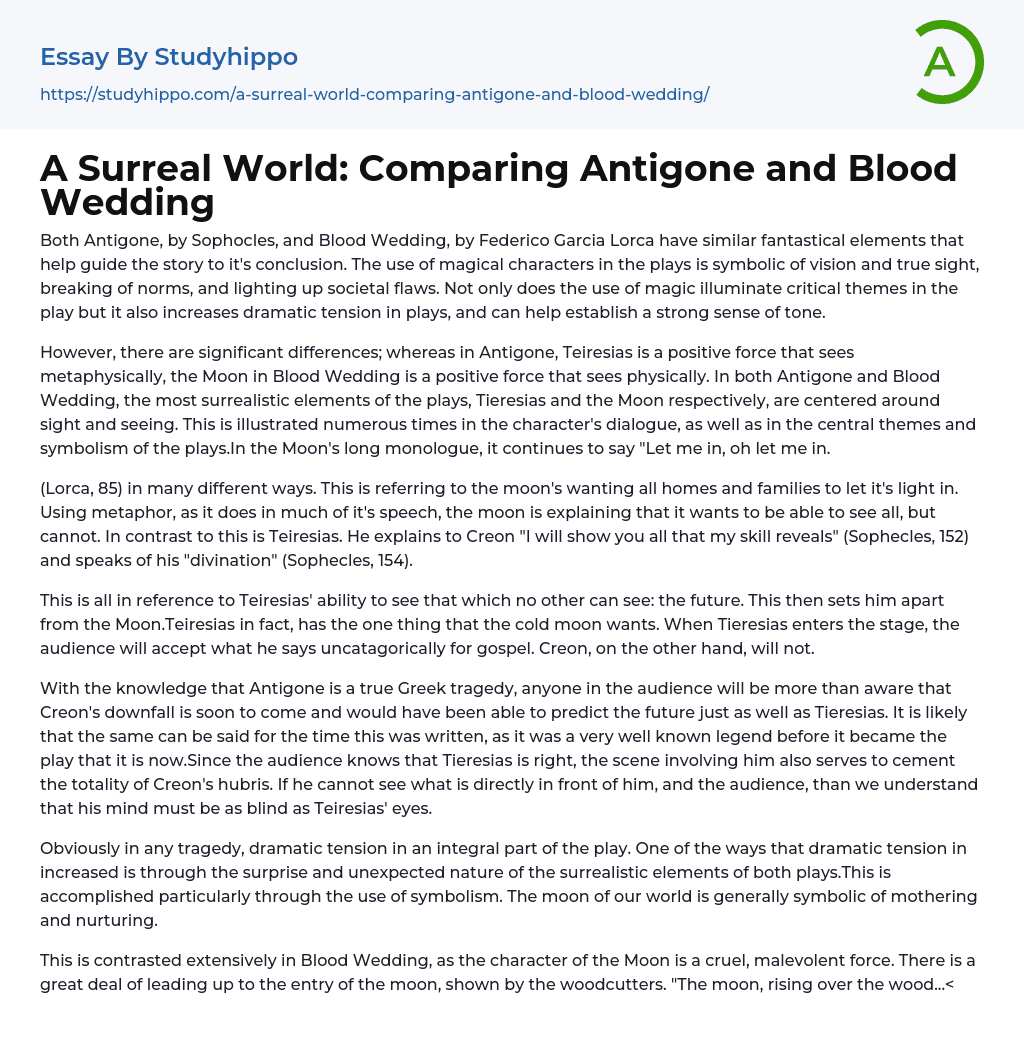

A Surreal World: Comparing Antigone and Blood Wedding Essay Example
Both Antigone, by Sophocles, and Blood Wedding, by Federico Garcia Lorca have similar fantastical elements that help guide the story to it's conclusion. The use of magical characters in the plays is symbolic of vision and true sight, breaking of norms, and lighting up societal flaws. Not only does the use of magic illuminate critical themes in the play but it also increases dramatic tension in plays, and can help establish a strong sense of tone.
However, there are significant differences; whereas in Antigone, Teiresias is a positive force that sees metaphysically, the Moon in Blood Wedding is a positive force that sees physically. In both Antigone and Blood Wedding, the most surrealistic elements of the plays, Tieresias and the Moon respectively, are centered around sight and seeing. This is
...illustrated numerous times in the character's dialogue, as well as in the central themes and symbolism of the plays.In the Moon's long monologue, it continues to say "Let me in, oh let me in.
(Lorca, 85) in many different ways. This is referring to the moon's wanting all homes and families to let it's light in. Using metaphor, as it does in much of it's speech, the moon is explaining that it wants to be able to see all, but cannot. In contrast to this is Teiresias. He explains to Creon "I will show you all that my skill reveals" (Sophecles, 152) and speaks of his "divination" (Sophecles, 154).
This is all in reference to Teiresias' ability to see that which no other can see: the future. This then sets him apart from the Moon.Teiresias in fact, has the one thing that the cold moon wants.
When Tieresias enters the stage, the audience will accept what he says uncatagorically for gospel. Creon, on the other hand, will not.
With the knowledge that Antigone is a true Greek tragedy, anyone in the audience will be more than aware that Creon's downfall is soon to come and would have been able to predict the future just as well as Tieresias. It is likely that the same can be said for the time this was written, as it was a very well known legend before it became the play that it is now.Since the audience knows that Tieresias is right, the scene involving him also serves to cement the totality of Creon's hubris. If he cannot see what is directly in front of him, and the audience, than we understand that his mind must be as blind as Teiresias' eyes.
Obviously in any tragedy, dramatic tension in an integral part of the play. One of the ways that dramatic tension in increased is through the surprise and unexpected nature of the surrealistic elements of both plays.This is accomplished particularly through the use of symbolism. The moon of our world is generally symbolic of mothering and nurturing.
This is contrasted extensively in Blood Wedding, as the character of the Moon is a cruel, malevolent force. There is a great deal of leading up to the entry of the moon, shown by the woodcutters. "The moon, rising over the wood...
the lonely, lonely moon... evil, evil moon..
. sad, sad moon" (Lorca, 84). This dialogue builds apprehension and excitement for the Moon's entrance.When the Moon finally is seen, and begins to talk of a "knife hanging in
the sky", "blood's warm cry", and itself being "cold as the dead", the audience reaction is that of shock, and confusion. These emotions build tension and increase the impact of the story. Antigone is similar in this respect.
Teiresias is essentially an old creepy blind man. The kind portrayed in many a Disney film that is eventually eaten by lions or whatever other fate occurs. Even if it was not the case at the time of writing, today we certainly associate Teiresias' type of character with evil people.This is why it is a surprise when we hear him begging Creon to heed his warning. And the shock is doubled when we realize that his warning is exactly what we think will happen. He explains to Creon: "The blight upon us is your doing.
" and tells him to "Pay to the dead his due" (Sophecles, 152). It is the contrast between the symbols engrained in our minds and those portrayed in the plays that assist with the raising of the dramatic tension. Thus it is the careful use of surrealism that propels the plays onto their inevitable climaxes.
- 1984 essays
- A Farewell to Arms essays
- A Good Man Is Hard to Find essays
- A Hanging essays
- A Lesson Before Dying essays
- A Long Way Gone essays
- A Rose For Emily essays
- A Separate Peace essays
- A Tale Of Two Cities essays
- A Very Old Man With Enormous Wings essays
- Adventures Of Huckleberry Finn essays
- Alice in Wonderland essays
- All Quiet on The Western Front essays
- Allegory of the Cave essays
- An occurrence at owl creek bridge essays
- Animal Farm essays
- Anthem essays
- Antigone essays
- Arthur Conan Doyle essays
- As I Lay Dying essays
- Atticus Finch essays
- Barn Burning essays
- Battle Royal essays
- Beauty and The Beast essays
- Beloved essays
- Boo Radley essays
- Brave New World essays
- Candide essays
- Castle essays
- Characters In Hamlet essays
- Characters In Romeo And Juliet essays
- Christmas carol essays
- Chronicle of a Death Foretold essays
- Cinderella essays
- Crime and Punishment essays
- Daisy Miller essays
- Death of a Salesman American Dream essays
- Desdemona essays
- Diary Of A Wimpy Kid essays
- Dracula essays
- Dubliners essays
- Emma essays
- Ender'S Game essays
- Ethan Frome essays
- Eveline essays
- Fahrenheit 451 essays
- First-Person Narrative essays
- Fish Cheeks essays
- Frankenstein essays
- Genesis essays



